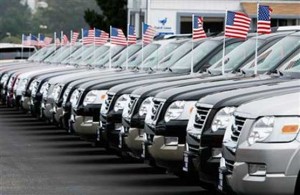The nation may be in the grips of a continent-sized cold spell but automotive sales continue to run hot, as they have for much of the year. Still, November’s unexpectedly strong numbers only barely conceal the fact that manufacturers may have gotten a bit too ambitious trying to take advantage of the best new car market since before the economy went into a nosedive six years ago.
While there are a handful of hot new models, like the 2014 Jeep Cherokee and the ’14 Chevrolet Corvette, that are flying off showrooms almost as fast as they’re delivered from the factories, dealers around the country are reporting bulging inventories of many other products, such as the Acura RLX and the Ford Fusion.
And that’s worrying industry planners and analysts alike. In years past, the build-up would have been a recipe for trouble, makers playing a game of chicken by ramping up incentives to maintain sales and market share – even at the cost of profits. It was precisely that sort of strategy that helped nearly sink the Detroit Three as the U.S. auto market collapsed in 2009 and 2010.
On the other hand, it meant great deals for consumers – those who could arrange credit during the economic crisis, that is. But this year, with automotive loans plentiful, and with interest rates near record lows, the inventory build-up could be a harbinger of some great end-of-year deals.
“It’s a real concern,” warns Dr. David Cole, chairman-emeritus of the Ann Arbor, Michigan-based Center for Automotive Research. “It’s going to be a real test to see if the industry sticks with their new policies,” he adds, noting that manufacturers like General Motors and Ford have said they no longer will blindly dump cars on the market but want to make sure production is carefully tied to demand.
(November car sales outpace expectations. Click Here for the full story.)
Demand and capacity are clearly out of line right now. According to data tracking firm Autodata, there are about 76 days worth of vehicles now on dealer lots compared to a norm of around 60. GM’s inventory ballooned from an already hefty 87-day supply in mid-October to 96 days worth of cars, trucks and crossovers a month later. Ford is now up to 93 days – 104 if you’re looking at just passenger cars – and Chrysler isn’t far behind.
Imports are also seeing a build-up, though it varies more widely by brand, from just 30 days inventory at Subaru and 38 days at BMW dealerships up to 109 for Honda’s Acura brand and 125 at Mitsubishi.
(What cars were hot, which ones not, in November? Click Here to find out.)
Mushrooming inventories could pose an even bigger problem if, as expected, “the pace of growth of the automotive market slows next year,” says Stephanie Brinley, an analyst with IHS Automotive.
“We definitely have more cars on the lot,” agreed Marvin Pinkney, the sales manager at Metro Ford, in Chicago, though he prefers to take the positive viewpoint of a long-time car salesmen, suggesting, “It’s better to have and not need than to need and not have.”
Potential buyers would likely agree. There have been times, over the last two years, when inventories were, if anything, at threadbare levels. Coming out of the recession, many makers were cautious to downright reluctant about boosting production. For shoppers, that often meant settling for what could be found on the lot or placing an order and waiting, often for months.
It also meant paying more. The average vehicle sold in November went for $32,769, according to data collected by Kelley Blue Book, up 3.0% — or $946 – from just the month before. Some of that increase comes as buyers load up on more options as the economy recovers. But it’s also due to makers using this year’s boom market to push up prices, like the 5% jump in the newly redesigned Toyota Corolla.
(GM hopes to turn frustrated owners into loyal buyers. Click Here to see how.)
Incentives, meanwhile, have been rising a bit in recent months, but to nowhere near the levels seen during the industry downturn – or even to the levels seen in years past when inventories were inflated.
“We’re now on a true turn-and-earn policy,” Mark Reuss, president of GM’s North American operations, tells TheDetroitBureau.com. “We’re running our plants based on what we sold last month.”
Ford officials have taken a similar position and the maker is showing its new approach by scheduling a week of downtime at the plant building its midsize Ford Fusion. Ford also has reduced earlier production plans for the coming quarter by about 2%.
But analysts like Cole and Brinley remain somewhat skeptical about whether the industry can maintain its discipline. It can be difficult to cut production and watch your sales and market share slide if competitors use that as an opportunity to pick up new business, and in the past, Detroit makers, in particular, have been able to maintain discipline only for so long.
“We’re not going to play the game,” insists GM’s Reuss, who admits that by over-building, stuffing vehicles onto vehicle lots and then slashing prices, “it hurts everyone.”
Well, not quite everyone. A price war could be great news for shoppers, but for an industry still recovering after one of the longest downturns in its history, it could prove a disaster on the bottom line.

